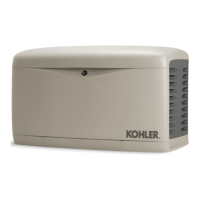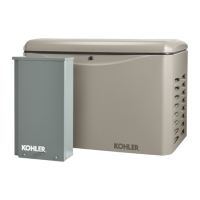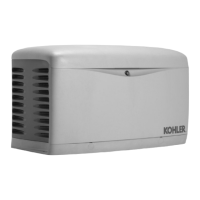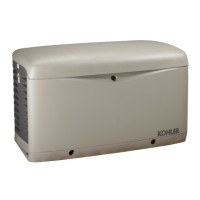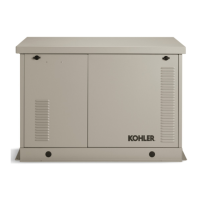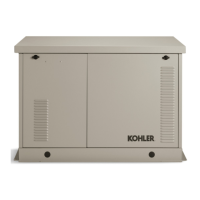TP-6805 8/15 103Section 6 Component Testing and Adjustment
6.8 Governor System
The governor system consists of an electromechanical
stepper motor (actuator) and an engine speed
detection/feedback circuit. The RDC2 or DC2 controller
controls the governor system operation. See Section 8,
Wiring Diagrams, for the governor connections.
6.8.1 Operation
The frequency of the alternator output is determined by
the speed of the engine. A two-pole alternator is driven
at 3600 rpm to provide 60 Hertz. (A 50 Hz model is
driven at 3000 rpm.) The engine speed is maintained by
an electronic governor system that consists of an
embedded controller and electric actuator (stepper
motor).
The governor system is controlled by the generator set
controller. The controller provides regulated power to
the bidirectional stepper motor actuator, which is linked
to the carburetor throttle arm.
The engine runs at a reduced speed during the warmup
and cooldown idle period of the cycle exercise. During
this time, the rotor field is not energized and the
generator will not produce voltage. When not producing
voltage, the generator will not be subject to large
changes in engine loading, so the governor response is
dramatically slowed to decrease throttle linkage wear
and fuel consumption. The response is also slowed
during cooldown and fault cooldown for the same
reason.
The engine speed adjustment setting in SiteTech allows
adjustment of the engine speed for testing purposes.
See Section 6.9.2. If the engine is hunting or surging, do
not adjust the engine speed. Test the governor
operation as described in Sections 6.8.3 and 6.8.4.
Then adjust the governor gain to stabilize the engine
operation if necessary before adjusting the speed. See
Section 6.9.1.
6.8.2 Initial Checks
The factory sets the electronic governor. Under normal
circumstances the electronic governor requires no
further adjustment. Verify that the governor stepper
motor moves smoothly and steadily during operation. If
the engine operates erratically, check the following
connections and conditions before adjusting the
governor.
Accidental starting.
Can cause severe injury or death.
Disconnect the battery cables before
working on the generator set.
Remove the negative (--) lead first
when disconnecting the battery.
Reconnect the negative (--) lead last
when reconnecting the battery.
WARNING
Disabling the generator set. Accidental starting can
cause severe injury or death. Before working on the
generator set or equipment connected to the set, disable the
generator set as follows: (1) Press the generator set off/reset
button to shut down the generator set. (2) Disconnect the
power to the battery charger, if equipped. (3) Remove the
battery cables, negative (--) lead first. Reconnect the negative
(--) lead last when reconnecting the battery. Follow these
precautions to prevent the starting of the generator set by the
remote start/stop switch.
D
Verify that the electrical connections are clean and
tight.
D Verify that the battery connections are clean and tight.
D Check for a loose or worn stepper motor/throttle shaft
coupling. Replace the shaft and bushing every 500
hours of engine operation.
D Check the carburetor for dirt, grime, or
misadjustment. Check for a loose mixer assembly.







